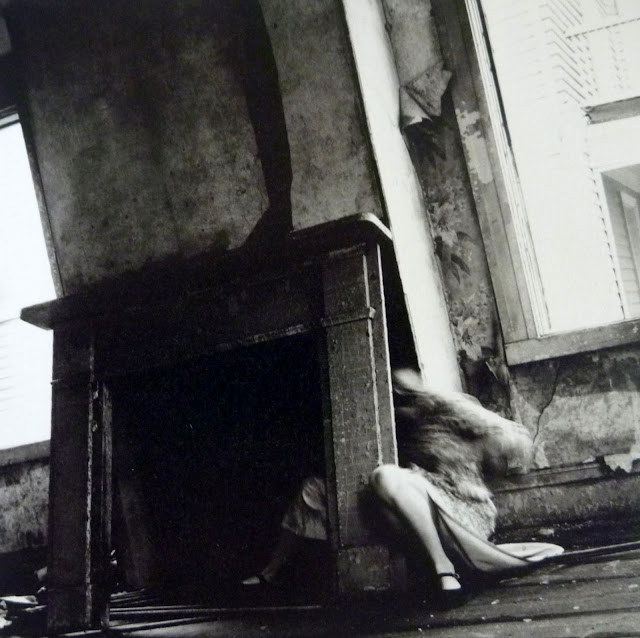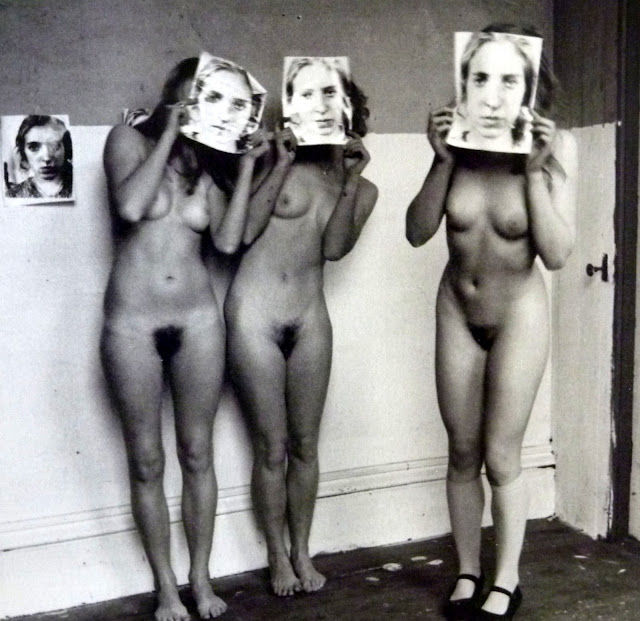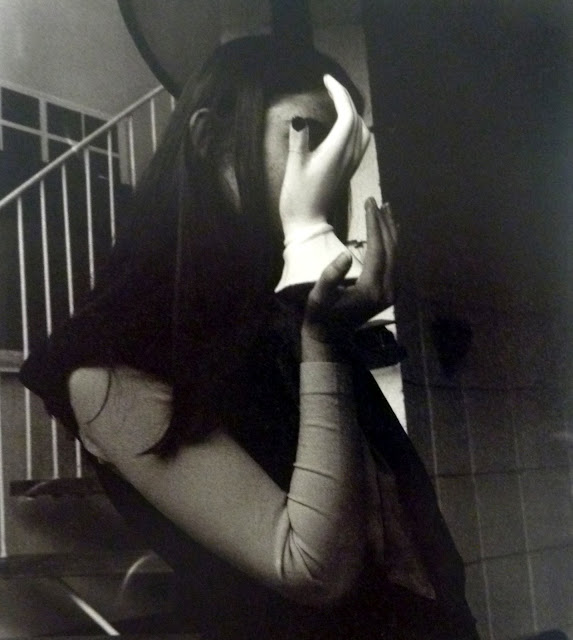Francesca Woodman
at the Guggenheim in New York.
Seen in New York last spring, but I have only now managed to write this up.
Her photographs represent an unusually coherent vision of an artist who had barely reached adulthood. An artist on the verge, neither mature woman nor innocent child - her art is inward looking, experimental and incomplete.
In 1931 Virginia Woolf, one of Woodman's favourite authors, encouraged an aspiring poet to celebrate the liberty and unfettered potential that youth afforded him, and to use this time to experiment with abandon:
'Write then, now that you are young, nonsense by the ream. Be silly, be sentimental... give the rein to every impulse; commit every fault of style, grammar, taste and syntax; pour out; tumble over; loose anger, love, satire, in whatever words you can catch, coerce or create, in whatever metre, prose, poetry or gibberish that comes to hand. Thus you will learn to write'.
We will never know whether Woodman's art was at this stage or how she would have developed.
* * *
Her preferred subject was herself from the first time she picked up a camera as a teenager. The fact that her main subject was her own body would logically place her work within the genre of self-portraiture, but she transforms it into a far more complicated and ambiguous undertaking. Not only is she both subject and author in her works, but she also alludes to a representation of self within the pictures, particularly through her use of mirrors and portraits.
'I kept trying to change my direction and photograph other things, I mean I am as tired as the rest of you of looking at me. But as you can see most of them are in this back section of less successful work. I think that I tried too hard to see why I do what I do - there are a lot of things which if I look at them too hard grow shy and stiff'.
'Woodman's self-portraits demonstrate an awareness that the genre is as much concerned with how representation is effected as it is with offering supposedly profound truths about the artist who effects that representation'. (Chris Townsend).
Early photographs - Providence, Rhode Island
White Socks, 1976

Untitled, 1976

House, no. 3
House, no. 4, 1976
Untitled, from House Series, 1976

Space 2 , 1976

Space 2, 1976
She had an affinity for decrepid and decaying interiors as the environments in which to work, but also in which to live. In these settings, she pressed her body into cupboards and cabinets, camouflaged against walls, or dissolved into a blur of movement.
During her freshman year she established her own studio in a dry goods building: lacking heat, a shower, and a proper kitchen, the space was not intended for living in. The eccentric environment Woodman created there was both a setting for her work and a performative manifestation of her personality.

Space 2, 1976
Some of her pictures were carefully plotted in advance, complete with preparatory sketches. But most of them were produced as she responded to her environment and her own imaginative flights of fancy.
'I am interested in the way people relate to space. The best way to do this is to depict their interactions to the boundaries of these spaces. Started doing this with ghost pictures, people fading into a flat plane - i.e. becoming the wall under wallpaper or of an extension of the wall onto floor.
Closer to what I am doing now is my beginning last spring with M or myself enclosed by a glass coffee table. Also video tapes - people becoming, or emerging from environment'.
* * *
She staged performances for her lens which are rarely narrative - instead, they are mysterious, suggestive, evocative and often allegorical.
Untitled, 1975-78
Her interests in the female body, Surrealism and the photographer's relationship to both literature and performance are very evident in her work.

Polka Dots, 1976
In her images the central figures are often out of focus, ghostlike, or hard to locate. Her work remains elusive to this day.

Polka Dots, 1976

Polka Dots, no. 5
Verticale, 1976
This photograph is paired with the one below and both raise a number of questions:
Horizontale, 1976
In this photograph we have the lower half of a female body seated in a chair, the legs wrapped in spiralling bands of constricting tape. A glove is held over the genitals. The figure sits atop a quilt, whose contrasting bands form triangles that add to the overall visual effect of instability. Is this a study in contrasts? Is this a conversation with Surrealism, as indicated by the glove and its fetishistic associations? Is this not reminiscent of the work of Man Ray or Lee Miller? Is this fleshly compression about bondage, pain and trauma?
Self Portrait Talking to Vince, 1975-78
Untitled, 1976
Her use of nudity is complex, oscillating between a position of sexuality and one of innocence. Nudity for Woodman is a state of being unclothed, of shedding the signifiers of identity as it is projected through clothing. This becomes clear in the above photograph where three young women pose for the camera, each holding a portrait of Woodman's face over her own. Two of the models are nude and not immediately identifiable: the third is obviously Francesca, given away by her familiar white knee socks and black Chinese slippers.
Untitled, 1976
There is a simultaneous courtship as well as a subversion of the male gaze in her engagement with the female body.
Untitled, 1975-78
Nike, 1975-78
Despite her perpetual presence in the photogtaphs, she is always on the verge of disappearance. Her face is most often obscured from the camera; on the rare occasions when she fixes us squarely in her gaze, the effect is riveting but disquietingly unrevealing.
Untitled, 1975-78
So many aspects to her work: seriality, questions about the female body, the gothic nature of the imagery, fetishism, narcissism, Surrealism.
Untitled, from Portrait of a Reputation, 1975-76
What markings or imprints do these outlined hands signal?
Untitled, 1975-76
And what about these?
Sloan, 1976
Untitled, 1975-76
Similar arm gestures in the two photographs above. What do they signify?
And I had forgotten how to Read Music, 1976
These two photographs are part of a related group, each annotated with a fragment about the process of learning and forgetting how to play music by heart.
Then at one Point, I did not Need to Translate the Notes; They Went directly to my Hands, 1976
Woodman wrote in her diary: 'What happened is that I played the piano for a long time. The pieces I played most were themes on variations, Scarlatti, etc. This occurs in my imagery'.
In music, this form of composition involves the production of increasingly elaborate variations on a simple theme; the result is a complex body of thematically related, but not necessarily sequential or narrative, pieces. This conception of music as an analogy for her working method as a photographer is made explicit in these photographs.
Untitled, 1976





















No comments:
Post a Comment